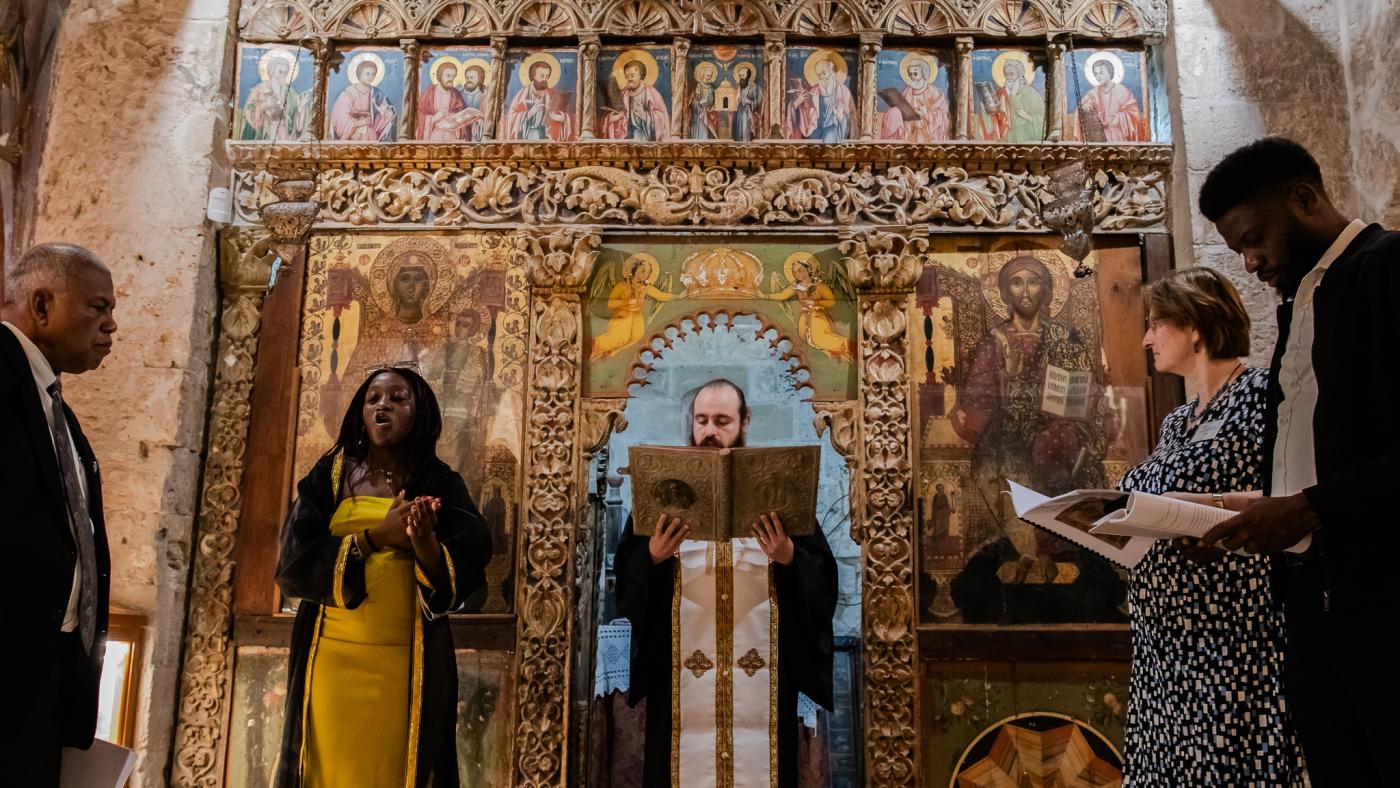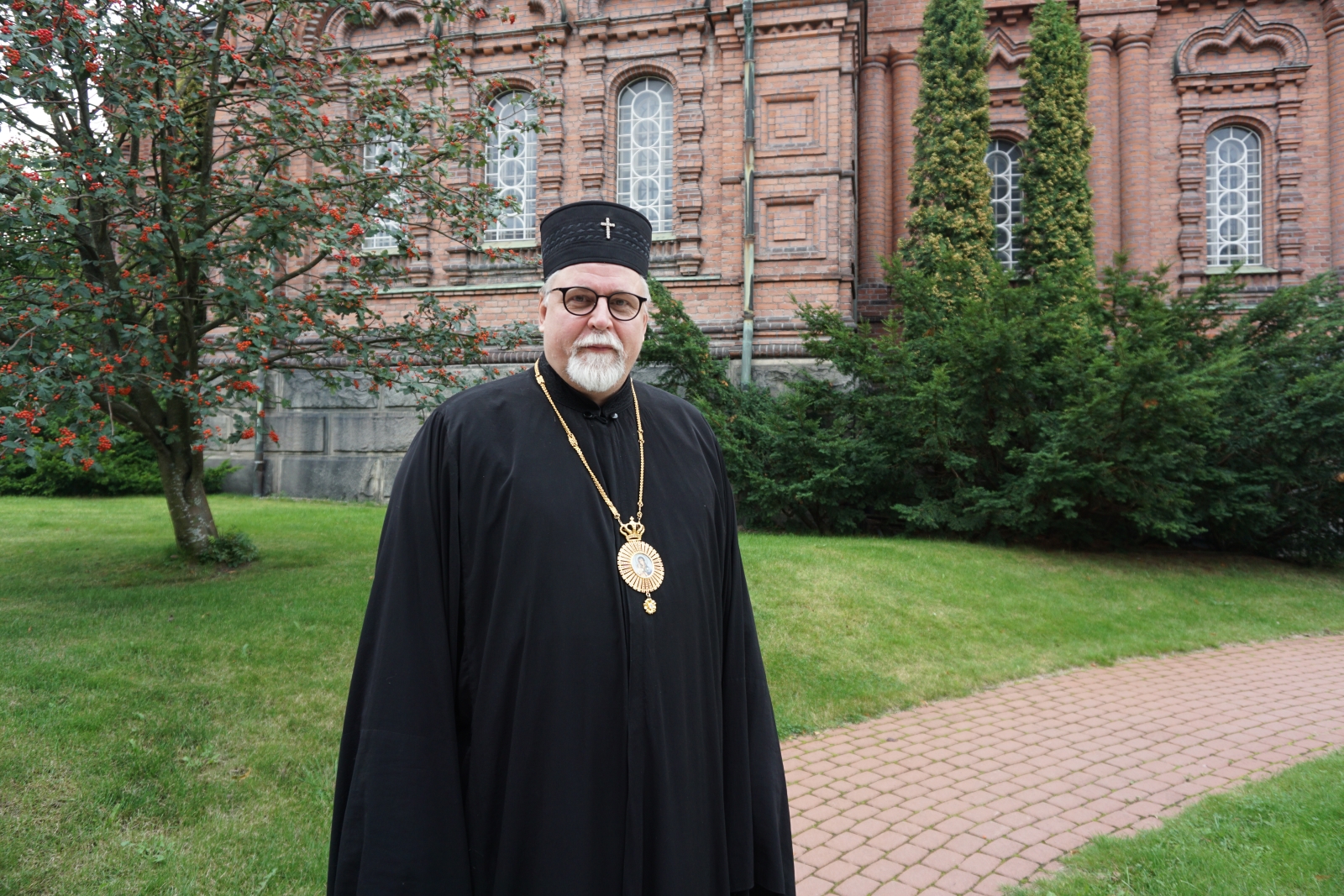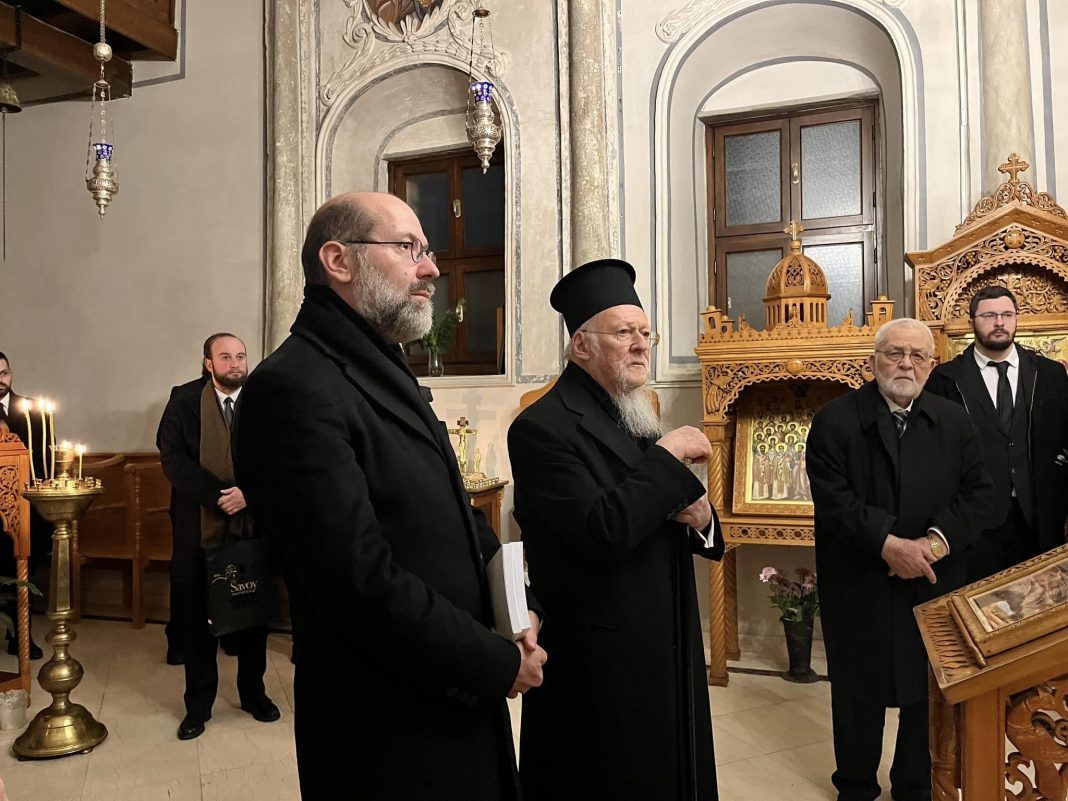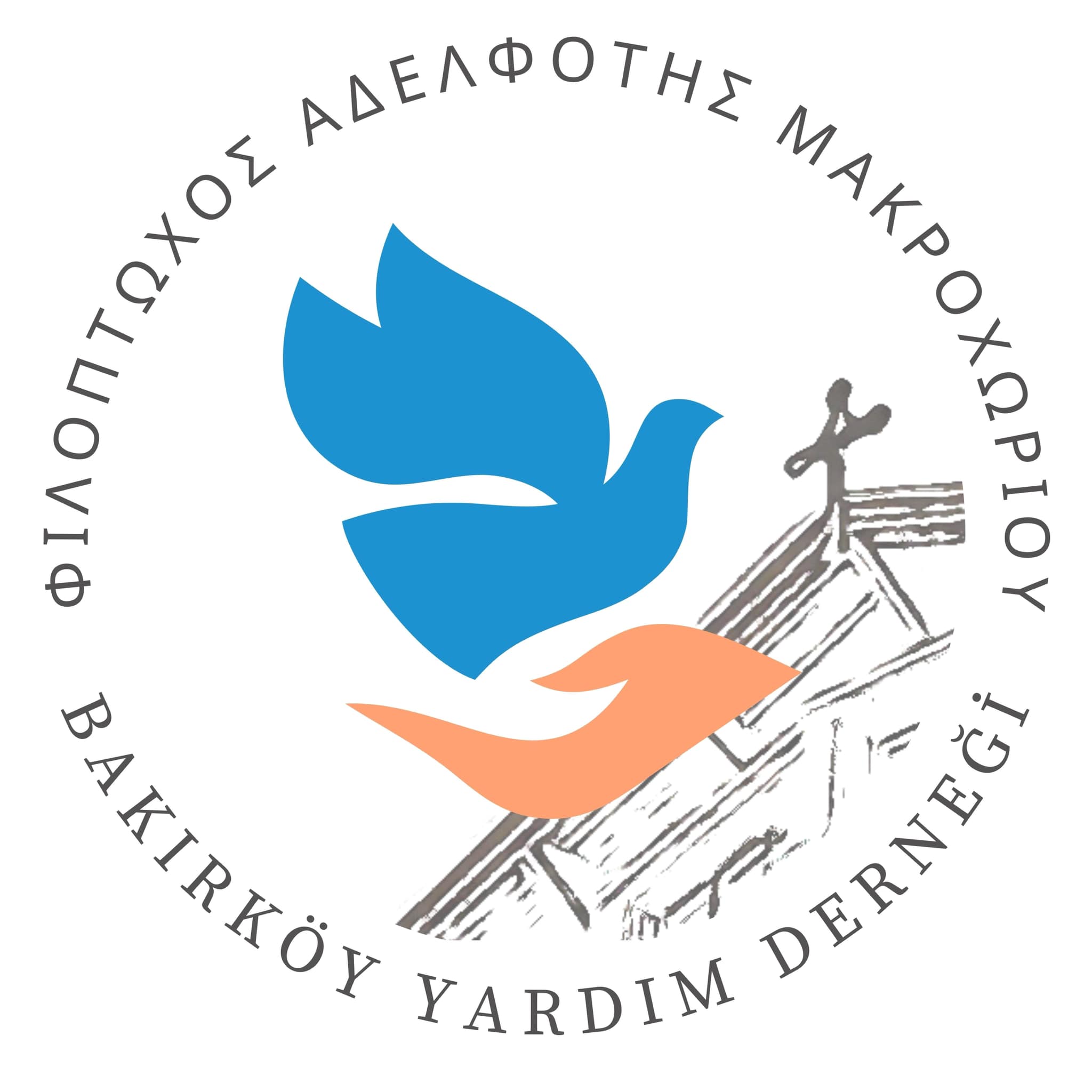The Miracle of the Trisagion (“Thrice-Holy Hymn”) (25 September)
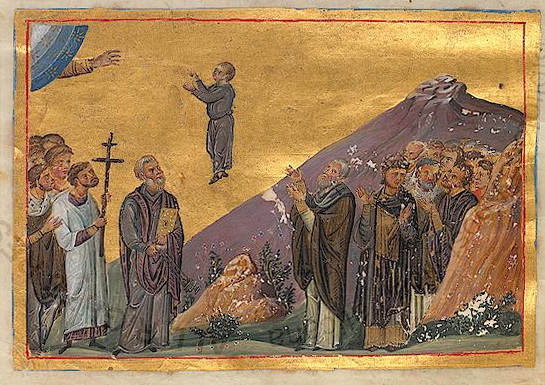

On the 25th of September, each year the Orthodox Church commemorates the miracle of the taking up into heaven by the angels of a child when Proklos was Patriarch of Constantinople (434-446) and Theodosios II was emperor.
“Above, the hosts of angels sing praise; below, men form choirs in the churches and imitate them by singing the same doxology. Above the Seraphim cry out the Trisagion Hymn; below, the human throng sends up the same cry. The inhabitants of heaven and earth are brought together in a common assembly; there is one thanksgiving, one shout of delight, one joyful chorus.” – St. John Chrysostom
“The unceasing and sanctifying doxology by the holy angels in the Trisagion signifies, in general, the equality in the way of life and conduct and the harmony in the divine praising which will take place in the age to come by both heavenly and earthly powers, when the human body now rendered immortal by the resurrection will no longer weigh down the soul by corruption and will not itself be weighed down but will take on, by the change into incorruption, potency and aptitude to receive God’s coming. In particular it signifies, for the faithful, the theological rivalry with the angels in faith; for the active ones, it symbolizes the splendor of life equal to the angels, so far as this is possible for men, and the persistence in the theological hymnology; for those who have knowledge, endless thoughts, hymns, and movements concerning the Godhead which are equal to the angels, so far as humanly possible.” – St. Maximus the Confessor
“During Proclus’ reign great earthquakes were occurring in Constantinople for four months continuously. Being struck with fear, the Romans went out of the city to the so-called Kampos, and were supplicating God and processing with the bishop night and day. One day, when the earth was shaking and all the people were continuously crying out the ‘Kyrie eleison’ (Lord have mercy), at about the third hour, suddenly and in sight of all a young child was taken up into the air, and a divine voice was heard around it announcing to the bishop and the people to process and to say thus: ‘Holy God, Holy Mighty, Holy Immortal, have mercy on us’, nothing else being added. Our father among the Saints, Proclus, accepting the decision, processed the people chanting thusly and the earthquake immediately ceased. The blessed Pulcheria and her brother, supporting the miracle, established that this divine hymn be chanted throughout the entire ecumene; and from that day all the churches sing to God each day.” [PG 108.244B-248A]
In his treatise The Orthodox Faith, Saint John of Damascus (8th c.) adds that “it is traditional that the Thrice-Holy Hymn was also sung in this manner at the holy and great Fourth Ecumenical Synod — that which was held in Chalcedon, I mean — for so it is reported in the acts of this same holy synod.” The Synod of Chalcedon was held in 451, but it is clearly accepted that the hymn was inserted into the liturgy between the years 430 and 450. Since then, of course, its use spread throughout almost every service of the Orthodox Church. Today, it is intricately combined even with the recitation of the Lord’s Prayer, both in the churches and in private devotion in what are known as the “Introductory Trisagion Prayers” that begin the majority of divine services.
The hymn was probably so completely embraced by the Church due to the fact that the Monophysite Antiochian Patriarch Peter the Fuller (circa 470) interpolated into the hymn the phrase “Who was crucified for us,” attempting to align his position with the Theopaschites (a particular group of Monophysites). In any event, Orthodoxy would not accept the change and it was eventually rejected by the 81st Canon of the Council in Trullo, in 692. It’s popularity also seems to be attested to by the early date of its appearance in the West, also, as we shall see below.
The mystagogical-anagogical interpretation of the Trisagion hymn by the Fathers of the Church is connected with the context of the Thrice-Holy, Angelic Triumphal Hymn we just examined [see source below]: the three holies of the Seraphic Hymn is expanded in the Trisagion as a hymn specifically to the three persons of the Holy Trinity. In discussing the hymn’s place in the Divine Liturgy, Saint Nicholas Cabasilas comments establish us in the choir of the angels (Cabasilas; 2002, 59ff. Cf. Symeon; 1984, 34ff.):
“Next [after the raising of the Book of the Gospels] we praise God himself, the Triune God, as the coming of the Saviour revealed him to us. The hymns which we sing comes to us from the angels, and is taken in part from the book of the sacred psalms of the prophet. It was gathered together by Christ’s Church and dedicated to the Trinity. For the Hagios [the Holy], which is repeated thrice, is the angelic acclamation [Is. 6. 3. Rev. 4. 8]; the words ‘Strong and Immortal God’ are those of the blessed David, who exclaims: ‘My soul thirsts for the strong and living God’ [Ps. 42. 2]. The Church which is the assembly of those who believe and profess the Trinity and Unity of God, played its part in gathering together these two acclamations, joining them, and adding the phrase, ‘Have mercy on us’; she wished to show, on the one hand, the harmony of the Old and New Testaments, and on the other, that angels and men form one Church, a single choir, because of the coming of Christ who was of both heaven and earth. That is why we sing this hymns after the bringing in and showing of the Book of the Gospels; it is as if we proclaim that he, by coming among us, has given us a place amid the angels, and established us in the heavenly choir.”
A number of structural liturgical factors, as well as the manuscript tradition for the Trisagion point to an origin outside the context of the Divine Liturgy. First, its structural hymnographic form—εὐφήμιον (refrain), glorification (Glory; both now.), ἀκροτελεύτιον (repeated last line), and περισσὴ (embellished, appendix repeat)—indicate its use as an antiphonal kanon, which would align itself well with its origin as a Constantinopolitan processional, as modern liturgiology has recently observed (Taft; 1977, 214ff.). Its use at the end of the Great Doxology and the witness of usage in the asmatic vespers of the cathedral rite in the Athos, Great Lavra MS Λ.165 shortly before the dismissal (Conomos; 1974, p. 70ff.) point to an origin in the Divine Liturgy as an entrance processional (introit) carried over from a wider processional, “stational” liturgical tradition (cf. Baldovin; 1987 and Mateos; 1971).
Tradition has also preserved a special tidbit of information pointing to this processional origin. It is recorded that the point of the perisse (the appendix troparion at the end of an antiphonal psalmody) was when the Emperor and his court arrived in the Church (Conomos; 1974, 27 and Wellesz; 1961, 107). The highly formalized court rituals spilled over into the public worship life and we know that on great feasts the Patriarch and Emperor entered the Great Church together. The purpose of the highly melismatic perisse had the practical application of covering a multitude of liturgical actions, prayers and petitions establishing the Patriarch on the synthronon before the scripture readings, which in Byzantine times was the actual beginning of the Divine Liturgy (Taft; 1977, 214ff., and 1979, 287. Moran; 1979, 178ff. Baldovin; 1987, 218ff.).
Anyone familiar with the Divine Liturgies of the Orthodox Church knows that the Trisagion is still chanted today (without the antiphonal psalmic verses, which disappeared without a trace) and its psaltic tradition is still quite vibrant. The only time when it is not chanted is on the feasts of the Cross, 14 September and the Third Sunday of the Great Fast, and the Great Feasts of the Master (Despotikai heortai), when two special alternative hymns take its place—on the Great Feasts the baptismal hymn All those who have been baptized in Christ… (Ὅσοι εἰς Χριστόν) and on the feasts of the Cross the We venerate Thy Cross, O Master… (Τὸν Σταυρόν Σου), possibly originating in Jerusalem. The daily form is as follows: It is chanted three times followed by a glorification (Glory to the Father and the Son and the Holy Spirit; both now and ever, and unto the ages of ages. Amen.). The last phrase (ἀκροτελεύτιον) and then repeated a final time as a perisse, announced with the word δύναμις from the deacon. The word means “power” or “strength,” an obvious command to chant in a more intense fashion. All of this takes place just prior to the appointed scriptural readings for the day:
Right choir: Ἅγιος ὁ Θεός, ἅγιος ἰσχυρός, ἅγιος ἀθάνατος, ἐλέησον ἡμᾶς.
Left choir: Ἅγιος ὁ Θεός, ἅγιος ἰσχυρός, ἅγιος ἀθάνατος, ἐλέησον ἡμᾶς.
Right choir: Ἅγιος ὁ Θεός, ἅγιος ἰσχυρός, ἅγιος ἀθάνατος, ἐλέησον ἡμᾶς.,
Left choir: Δόξα Πατρὶ καὶ Υἱῷ καὶ ἁγίῳ Πνεύματι.
Right choir: Καὶ νῦν καὶ ἀεί, καὶ εἰς τοὺς αἰῶνας τῶν αἰώνων. Ἀμήν.
Left choir: Ἅγιος ἀθάνατος, ἐλέησον ἡμᾶς.
Deacon: Δύναμις.
Right choir: Ἅγιος ὁ Θεός.
Left choir: Ἅγιος ἰσχυρός.
Right choir: Ἅγιος ἀθάνατος, ἐλέησον ἡμᾶς.
On Sundays and great feast days when there are many clergy serving the typika, euchologia and music manuscripts preserve a repeating of the hymn even more than three times, with the antiphonal chanting including the choir of clergy from within the holy altar (bema), something still practiced even today….
To summarise regarding the Trisagion, its divinely revealed origin attests to its popularity, as does its use throughout the Church’s daily worship cycle. It looks to be an expansion on the Angelic, triumphal thrice-holy hymn, developing its Trinitarian character to address each person of the Godhead individually.
The Trisagion prayers, the introductory prayers used to begin almost every service, just before the Lord’s Prayer, are among the first prayers learned by an Orthodox believer. The term Trisagion service has come to refer to the memorial service for those who have fallen asleep in the Lord. For our purposes here, though, we emphasise the use of the Trisagion as a vehicle of anagogy.
Source: John Sanidopoulos

